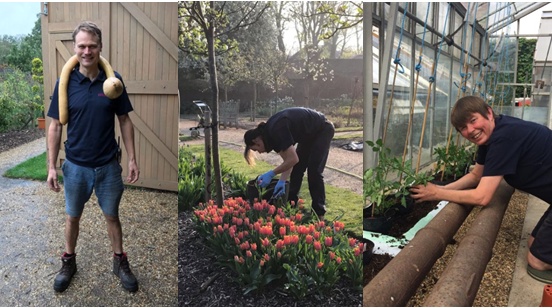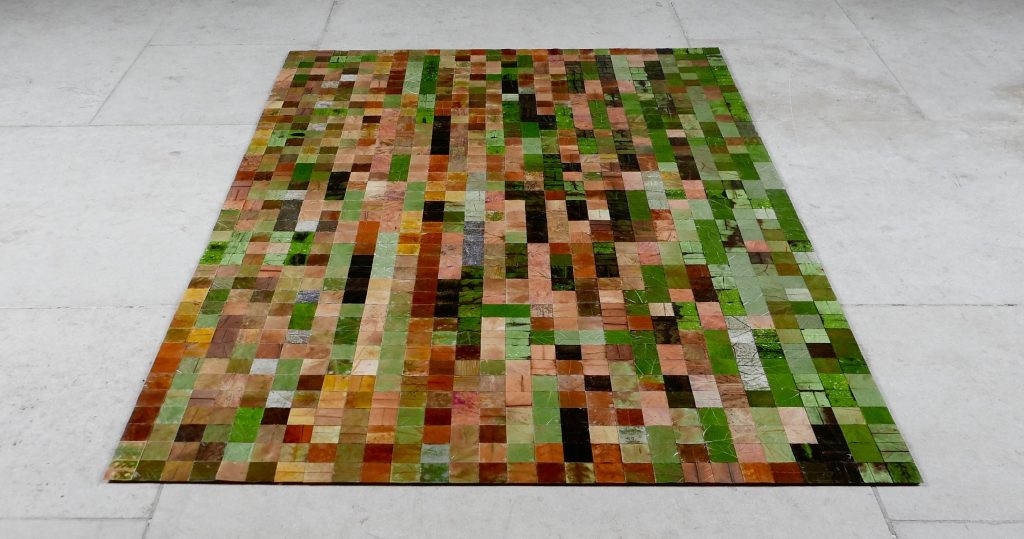The making of Jaimini’s artwork: a gardener’s perspective
Visitors to the House will encounter the second installment of Jaimini Patel’s intricate artwork, presented as part of our current exhibition Bring Into Being.
Patel’s Matter as the densest form of energy – energy as the lightest form of matter, displayed in the Upper Link Room was created from Spring to Summer, and consists of foliage collected from the Gardens. Those who know their plants will spot burdock, iris, gladioli, magnolia, lime, beech, acuba and allium leaves to name a few.
Here, our gardeners, James Aufenast, Geraldine King and Chris Greer reflect on their experience of working alongside the artist on this ambitious project and share their thoughts on the work exhibited in the House.

James Aufenast: Jaimini met us in the Kitchen Garden to explain exactly what she was looking for. This particular artwork required larger leaves that she could cut and shape. We suggested some examples and stressed the importance of picking the lower leaves (which die off first as the plant grows, so it’s fine to catch these before they’re finished without affecting the whole plant if it has other, healthy leaves). Jaimini then went off and sourced these leaves both from the Kitchen Garden and from the wider estate. She also joined us when we were coppicing Hazel as this threw up another source of materials.
From the outset Jaimini stressed her ambition to re-purpose garden waste, and she was also a regular visitor to our compost heap throughout the making process. She made use of the allium leaves as we stripped them down in the Italian Garden and she was particularly helpful with using the acuba which we are trying to reduce in the gardens.

Now that we have seen the process, what do you think of the completed works Geraldine?
Geraldine King: I’m always amazed at the talents of artists to patiently collect and work with living material and bring it alive in a way that is non-characteristic to the plants intentions. I liked the concept and when you see the piece woven together like a patchwork carpet of leaves it really does have the wow factor. The second piece is formal but very striking and an awful lot harder to identify the material used to create this amazing artwork.
James Aufenast: I know what you mean. It’s surprising for me to see leaves that have their own organic beauty and shape constrained into the straight lines of Jaimini’s artworks. It’s also both weird and exciting to see greenery and the essence of Gardens brought into the House. For me, these artworks are halfway between the Gardens and the House, a kind of place between nature and formal architecture. You can see the vague outlines of some leaves and I recognise what they are, but they have become more about the colour and shape in contrast with the leaf next to it, so they lose their individual identity. What are your thoughts Chris?
Chris Greer: I love both pieces even though they’re so different. It’s like the garden made solid. Outside the Gardens are always changing but this is fixed. It’s great to see a bit of the Garden in the House, almost a mirror image of how the estate is in reality. Jaimini has distilled the essence of the Gardens into a fixed object.

Jaimini’s site-responsive installation is composed of fallen, pruned and weeded leaves and flowers collected from the Kitchen Gardens and grounds of Chiswick House. The work is on display inside Chiswick House until 31 October. Part of Bring Into Being, featuring works by Peter Adjaye, Jaimini Patel and Mark Wallinger, included in ticket to visit Chiswick House. Book tickets.